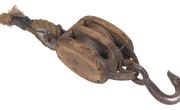
A block and tackle pulley is a machine that greatly reduces the amount of force necessary to move or lift an object such as a heavy crate. A standard pulley is composed of a single wheel on an axle with a rope running over it. On its own, a pulley can only change the direction of a force applied to an object. A system of pulleys working together can form a block and tackle, which multiplies force in addition to changing the force's direction, meaning less force is required to move an object. The degree to which the block and tackle multiplies force is its mechanical advantage.
Function
Block and tackles are frequently used in areas where heavy machinery is not available and human power must be substituted instead. In antiquity, block and tackles were used in construction projects to move heavy loads. In the modern era, they are used frequently on boats where it would be impractical to have a crane or other heavy lifting machinery.
Lifting With A Pulley
If we were attempting to lift a 200 lb. crate from the floor into the rafters of a building, we could do it by using a simple pulley. We would put one pulley in the rafters and pass a rope through it, attaching one end of the rope to the crate. By pulling the other end of the rope (the hauling part), we could lift the crate into the rafters. In this system, each time we pull the rope one foot with 200 lbs. of force, we lift the crate one foot. Lifting with anything less than 200 lbs. of force will not move our 200 lb. crate.
Lifting With A Block and Tackle
If, instead of attaching the rope directly to the crate, we passed it through a new pulley attached to the crate and then attached the end of the rope to the rafters, we would have a block and tackle. Now, each time we pulled the free end of the rope, the rope would have to travel between the rafters and the crate twice. We would have to pull two feet on the rope to lift the crate a single foot. However, we would only have to pull with 100 lbs. of force.
Mechanical Advantage
This disparity between the amount of force required to move an object and the weight of the object is the mechanical advantage of the block and tackle. This is the same as the disparity between how much rope we pull compared to the distance the object moves. To calculate the mechanical advantage, we can either divide the weight of the object being lifted by the force required to lift it or we can divide the amount of rope we have to pull by the distance the object moves. To find the mechanical advantage of our machine by the first method we would divide the crate's weight, 200 lbs., by the amount of force required to lift it, 100 lbs., giving us a mechanical advantage of two. Dividing how much rope we haul at a time, 2 feet, by the distance the crate rises, one foot, gives us the same answer. As a rule of thumb, the number of lengths of rope between the two pulleys in a block and tackle corresponds to the mechanical advantage of the machine. In our machine the rope passes from the top pulley to the bottom pulley and back up to the rafters: two lengths of rope gives us our mechanical advantage of two.
Force and Work
Even though a block and tackle decreases the amount of force necessary to move an object, it does not change the amount of work. For example, a block and tackle with a mechanical advantage of four will allow you to lift a 4 lb. object with only 1 lb. of force. However it will also require you to pull 4 feet of rope to lift the object one foot.
Friction
When any object moves against another object, some of the moving object's energy is lost to friction. In a block and tackle, some friction in the pulleys will reduce the mechanical advantage of the machine. To include friction in a calculation of the mechanical advantage of a block and tackle, divide the weight of the object being lifted by the weight necessary to lift it.
References
About the Author
David Weinberg began writing in 2005 at New College of Florida, composing articles on history and political science for publication within the school and for online circulation. Weinberg has been a professional outdoor educator for more than five years with experience throughout the United States.
Photo Credits
ship's block and tackle image by David Smith from Fotolia.com
